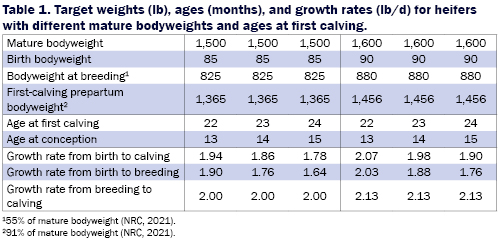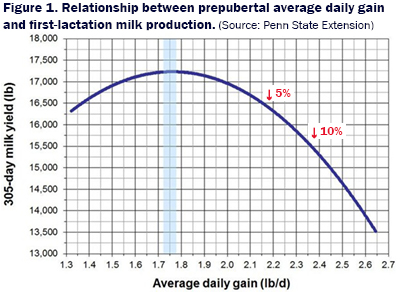
Target growth weights in weaned heifers
 By Dr. Lucas Mitchell, Vita Plus dairy calf and heifer specialist
By Dr. Lucas Mitchell, Vita Plus dairy calf and heifer specialistThe importance of preweaning growth gets a lot of attention and rightfully so. It is well understood and accepted that a good start for preweaned calves yields dividends on their health and future lactation performance. As a result, many farmers try to get their preweaned calves to grow as fast as possible while finding the balance of milk and solid feed intake that fits their calf program. The minimum growth goal for calves is to double their birth bodyweight by 60 days of age. This is a fairly universal growth goal that can be applied across many farms. To accomplish this goal, an 85-pound heifer calf would need to grow at least 1.42 pounds per day. Most farmers would agree this is a minimum expectation with many targeting growth rates that far exceed this goal.
After calves are weaned, the idea of growth goals and targets seem to fade. The next important steps in a heifer calf’s life are breeding followed by freshening. How heifers grow between weaning and breeding and between breeding and freshening varies farm to farm, often with more thought given to age than a specific growth goal. This leads to some farmers pushing their heifers to grow as fast as possible, some letting off the gas, and others falling somewhere in the middle. While there is no universal growth target for weaned heifers, farmers should take the time to develop target growth goals for their weaned heifers because, if they don’t, they may be unintentionally losing first-lactation milk.
To set target growth goals for weaned heifers, a couple farm-specific questions need to be answered:
- What is the mature bodyweight of cows on the farm?
- What is the target age at first calving?
Mature bodyweights should be collected from cattle that are third-lactation or greater and at peak to mid-lactation. Table 1 demonstrates the importance of these two questions as the answers impact target bodyweights at breeding and first calving as well as target growth rates.

With Table 1 in mind, it is also important to consider the impacts prepubertal growth rate, bodyweight at freshening and body condition score may have on heifer performance. Prepubertal growth rate is the rate of growth that heifers achieve between approximately 4 and 10 months of age. Figure 1 is from a Penn State University Extension article and shows the relationship between prepubertal average daily gain and first-lactation milk production that was found in a meta-analysis. It is important to note that this data was from Holstein heifers. There is a slight loss of about 5% milk for heifers grown up to 2.2 pounds per day during this period, but the losses are exacerbated to about 10% for heifers grown up to 2.4 pounds per day from 4 to 10 months of age.

Heifers should freshen with a prepartum bodyweight of 91% of mature weight, while postpartum bodyweight should be 82% of mature weight according to the new NRC (2021). Studies have shown that, when heifers freshen too light, they will not produce as much milk in the first lactation. This is likely due to more energy going toward growth during their first lactation.
When pushing to hit those bodyweight targets, it is important to track body condition score. Research from Penn State University found that heifers that experienced the greatest amount of bodyweight change after freshening, presumably those with the greatest body condition, were more likely to leave the herd early. If target bodyweights at freshening cannot be accomplished without over-conditioning heifers, it may be necessary to evaluate early life growth or whether target age at first calving should be adjusted.
Target growth rates for weaned heifers should be determined on a farm-to-farm basis. Calves should double their birth bodyweight by 60 days of age. After weaning, heifers should grow to achieve 55% of mature bodyweight at breeding, while keeping in mind too fast of growth from 4 to 10 months will cost them milk in the first lactation. After breeding, the target growth rate should be adjusted to allow heifers to hit 91% of mature bodyweight prepartum. During this whole process, it is important to keep body condition score front of mind to ensure that heifers are continuing to grow frame and not become over-conditioned.
Depending on the data your farm currently collects, it may not be easy to determine your farms target growth rate for weaned heifers. However, it is certainly worth the time and will payoff once those precision-grown heifers enter the lactating herd. Reach out to your calf and heifer specialist to put together a game plan to ensure your heifers are growing to meet your farm’s goals.
| Category: |
Calf and heifer nutrition Starting Strong - Calf Care Technology and data management |

